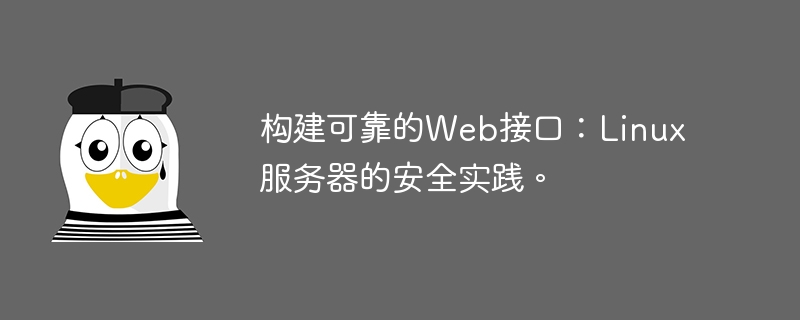

Building reliable Web interfaces: Security practices for Linux servers
As the hub for modern applications to interact with the outside world, the security of Web interfaces is crucial of. Building a reliable web interface on a Linux server is an important part of ensuring system security. This article will introduce some security practices for Linux servers to help developers and system administrators build more reliable and secure Web interfaces.
It is important to keep your operating system, web server, and related software up to date. Linux distributions provide an automatic update mechanism to regularly check and apply security patches and updates. Ensuring that systems are always up to date can prevent known vulnerabilities from being exploited and improve server security.
Configuring the firewall is one of the key measures to protect the server from unauthorized access. Linux servers are usually pre-installed with firewall tools such as iptables or firewalld, which can restrict network access by configuring rules. Only allowing required ports and protocols to pass through and blocking unnecessary network traffic can reduce the potential attack surface and improve server security.
Using secure connection protocol is an important means to ensure the security of Web interface communication. In general, HTTPS (based on SSL/TLS) is widely used for secure web communication. Configuring a valid SSL certificate for the server and enabling HTTPS connections can ensure encryption and integrity verification of data during transmission and prevent the leakage and tampering of sensitive information.
By configuring access control, you can limit user access to the web interface and provide a more secure access method. For example, you can prohibit using the root user to directly log in to the server, use ordinary users to perform operations, and limit their permissions. In addition, you can configure access control lists (ACLs) to restrict access to specific IP addresses or IP segments to reduce potential attack risks.
Establishing an effective monitoring and logging mechanism will help to promptly discover potential security issues and abnormal behaviors and provide timely responses. You can use tools such as fail2ban to monitor the number of failed login attempts and temporarily prohibit access from the source IP address. In addition, you can also use logging tools to record system events and network traffic to facilitate source tracing and analysis to ensure server security.
Strong passwords are one of the important measures to protect servers and web interfaces. Passwords should contain uppercase and lowercase letters, numbers, and special characters, and be of a certain length. In addition to strong passwords, you can add security by enabling multi-factor authentication. For example, use SMS verification codes, token devices, etc. as supplementary methods of identity verification to ensure that only authorized users can access the system.
Backing up data regularly is an important step to ensure high availability and data integrity of the web interface. Backup operations should be performed without affecting normal operations, and backup data should be stored in different physical locations or cloud storage to avoid data loss or damage. In the event of unforeseen circumstances, backup data can be relied upon to quickly restore the system and protect the interests of users and the company.
Summary:
By following the above Linux server security practices, you can help build a reliable web interface and improve the security of the server. These practical measures cover security configuration, access control, monitoring logs, password policies, data backup and other aspects, providing effective protection for protecting servers from potential threats. In the process of developing and maintaining Web interfaces, security is always the key. Only by ensuring the security of the server can users' information and interests be effectively protected.
The above is the detailed content of Building reliable web interfaces: Security practices for Linux servers.. For more information, please follow other related articles on the PHP Chinese website!




